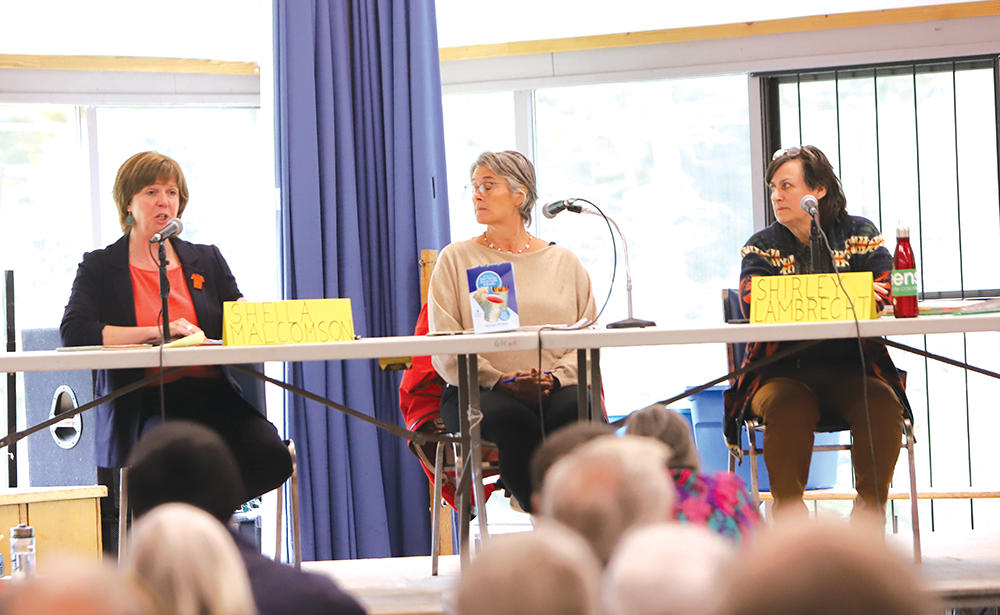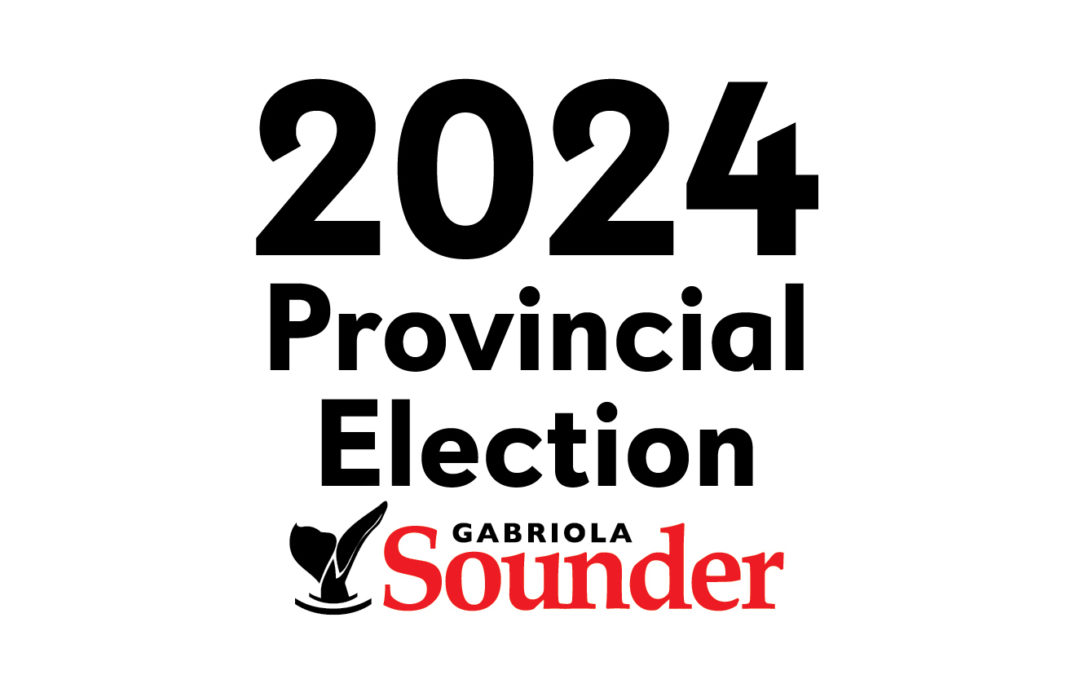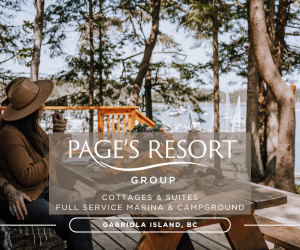
L-R: BC NDP candidate Sheila Malcolmson, moderator Talyn Martin, and BC Green Candidate Shirley Lambrecht. Sounder News photo
Derek Kilbourn
Sounder News
With the Provincial Election in full swing, there are a number of all-candidate forums being held throughout the Nanaimo-Gabriola riding.
As of press time, there were three candidates listed for Nanaimo-Gabriola.
Two came to the All-Candidates forum hosted by Gabriola Talks at the Gabriola Island Community Hall this past Saturday, September 27: Shirley Lambrecht, running for the BC Greens; and Sheila Malcolmson, a two-time MLA, running once again for the BC NDP.
Dale Parker, the Conservatives Party of BC candidate, had said he would attend, but was unable to do so. A representative for Parker sent regrets, saying Parker had undergone surgery and was recovering.
Viraat Thammanna had been listed on the ElectionsBC web site as a fourth candidate in the riding. He had withdrawn from the election before the 1pm deadline passed on Saturday and did not participate in the forum on Gabriola.
Question: What is your party’s approach to the replacement of the terminals in Nanaimo and Gabriola?
Lambrecht: I’ve been learning more about some of the challenges you are facing. One of the things I’ve learned about is the electrification of the terminal. So there’s cost, there’s frequency, there’s making sure we’re able to access services when we need them. In terms of through-put, we want to make sure you have access to the ferries. We need to get people where they need to go. We need to do it effectively, and as cost-effectively as possible. For some, the rates are a barrier, they create a barrier in managing finances. We also need to be looking at transportation end-to-end. It’s also where do you need to go next when you get off the ferry. We need to look at the whole piece. Who are you, and where are you going, and how will we get you there? To make sure we’re putting the money where we’re going to go.
Malcolmson: I’ll flag that the FAC [Ferry Advisory Committee] is doing really good work. The near-term solutions, moving the stop sign, putting in they crosswalk, feel like such doable things. I’m sure they are still in play with the Ministry of Transportation. And if I get to be the MLA for this side of the ferry I’ll certainly be pushing for those.
Also grateful that islanders pushed so hard on the ferries, that we rolled back the minor rout cuts, that we restored that seniors ride for free, some of the things we did to mitigate the damage done by the previous government.
Question: How would your government create pathways for supporting Indigenous protected and conserved areas under BC Law?
Malcolmson: this is vitally important work we already have underway, but it hasn’t been a lot in the headlines. I’ll start by saying that everything I say, the Conservatives, say they will throw it all out. So this is a significant piece of work that’s at risk. To have just this fall, come together with a tripartid agreement of Coastal First Nations, BC, and Canada, a billion dollars already committed…to reach 30% protected land and water by 2030. We are going to get there because of First Nations. I don’t think there is anywhere else in the world that we can see that coming together.
Extremely important. Coastal First Nations have just this late spring announced the largest marine protected area around the Great Bear Rainforest and the areas south. Groundbreaking work around conservation with First Nations. And another $30 million fund that [the NDP Government] put together with the BC Parks Foundation, our money, working with First Nations and BCPF for another fund. All working towards our [climate] commitments as well as UNDRIP.
Lambrecht: my biggest concern is we have not been respectful with our relationship with Indigenous people. In terms of sovereignty and their right to protect their land. I look at us as coming to them and asking Indigenous people them to lead the conversation. We’re not always good at listening. We’re very good at telling. It’s very important that we allow our Indigenous communities to lead the conversation. They looked after these lands for thousands of years, and did a wonderful job of it. In a short amount of time, we’ve done a lot of damage. We need to let Indigenous people lead the conversation.
Question: what are specific concrete ways that you or your governments would take with the relationship with Snuneymuxw First Nation and build on it?
Lambrecht: we have a very difficult history to overcome working with Indigenous people. We have so much healing that we need to do, we need to engage again as listeners rather than tellers. It has been my goal to embed Indigenous ways into how we govern. The Legislature is a colonial organization when you look at how we do things.
When I look at the traditional ways of Indigenous peoples. It’s a more organic ways of governing. The Conflict resolution of Indigenous people. We need to incorporate that into how we govern.
Malcolmson: 20 years ago I stood in this same place [the Community Hall] and heard appallingly racists things being said about Snuneymuxw while they stood and listened.
I have loved working with Snuneymuxw. I’ll talk about some of the successes we have had. The only protocol agreement that the Province has though BC Housing is with Snuneymuxw. They are building with our money, they are building hundreds of affordable housing projects. The Federal government should be building housing, they haven’t, so our NDP government is stepping in and doing that work. Snuneymuxw is the first place in the province that I know of with a school built on the reserve land, with SD68. It’s a beautiful school. Landback has been a long and solid call – our government has acquired a huge parcel of land – and recently purchasing the site of the Howard Johnson site, a sacred village site for Snuneymuxw. A commitment of $20 million. It wasn’t budgeted, but it had to be done. We would rather move ahead in cooperation in doing the right thing rather than fighting in court.
Question: homelessness is hitting Nanaimo hard, and Gabriola. It is difficult to do the work needed because our local government can’t deal directly with the related issues.
Malcolmson: Homelessness and addiction, those are provincial responsibilities – and work has been done, but oh my goodness. You’d never know we have already opened a thousand affordable homes in Nanaimo. They were gone in a flash.
We got 50 addiction beds in Nanaimo. Filled in a flash. We’ve opened two more centres, one in Duncan and one in Snaw-Na-Was in Lantzville.
With the school district, mental health and addiction teams. Moving the silos between service providers with a focus on mental health and addiction in young people.
The rising tide of global pressures of inflation and the pandemic mean we continually have to do more. Significantly more. I’m concerned with safety issues relate to homelessness in a community that is continually at risk with fire danger. People don’t feel safe on the street in Nanaimo, we don’t want them to have to take the ferry to Gabriola. And we don’t want people on Gabriola to be evicted. The housing crisis we can prevent right here at home. For us, the banning of commercial vacation rentals is one of the quickest ways we can open up our rental market, credit to the Gabriola Trustees for opting in to the provincial ban, that will help.
Lambrecht: the issues of drug addiction, homelessness, and public safety are so interrelated, you cannot separate them out. But they do each have to be dealt with.
We have a crisis in Nanaimo of homelessness. We know of 551 people who are declared homeless at this point. We have 69 shelter beds. That math, there are eight people per bed. That makes a pretty cozy bed. We have an awful lot of people, that we’re not funding enough, to serve the crisis we’re in. Sometimes the homelessness leads to addiction, and sometimes the addiction leads to homelessness. Unfortunately, when people are out in the street, they will arm themselves to protect themselves. That creates a whole other layer of problems.
The Duncan village was amazing in showing when we house people, and provide services, crime actually goes down. That’s one initiative that got a handful of people off the street. People on the street are vulnerable. We need to be building more low market housing, social housing, co-op housing we need to get people behind locked doors so they can feel safe. As we do that, as we deal with the toxic drug crisis that we’re dealing with, crime rates will go down, communities will become safer.
Question: the roads here on Gabriola are a provincial responsibility, our taxes go up, our roads are an absolute disgrace, I think that’s putting it mildly.
Malcolmson: fair comment, as a cyclist on the island, I feel every bump. Yes, our roads are a provincial responsibility. We have not raised taxes. When we assumed power in 2017, we kept them low. So if you make under 150K a year, you pay the lowest provincial tax in the country. We have no intention of changing that.
That does not change the fact we have potholes and cracks in the road.
This is a challenge. When Gabriola went to the vote as to whether to become a municipality. Because our roads were built primarly on logging slash, they weren’t built to current standards. I remember being in a community meeting when the road crews came in saying the cost of repairing the roads if there was a catastrophic failure? Right now, if there’s a failure, the provincial taxpayer across the province would pay to repair.
It continues to be a problem, we patch. It’s always going to be a problem for us.
I’ll say for right now, I’m going to continue if I get to be Gabriola’s MLA, to advocate for the investments that we need here to maintain roads, to have them to be smoother, and to be safe. I will also say that while we are doing seismic upgrades on schools, building the new tower for Nanaimo Hospital – there’s such a backlog, such a social deficit, such an under-investment in infrastructure, it will take time for us to make up. It’s a challenge to set those priorities.
Lambrecht: we have enough money in the budget, it’s what we’re spending it on.
The fact is, when the NDP took over power, I believe we were at a budget of $3.5 billion, that mushroomed to $16 billion
You think about how much infrastructure you can repair, how much services you can fund, how much you can re-allocate into health care, education, social services, into all kinds of technology. That’s a lot of money.
During the [last] election, the NDP said they would stop Site C. I worked for the engineers for decades, anyone that looks at that project is shaking their heads.
Question: we are in a medical problem in the province, we are lacking doctors.
Malcolmson: Anybody who doesn’t have a family doctor, I really recommend that you get on the Health Registry. If you have difficulties doing that, call 811, and they can get you on. Because that helps whoever is the MLA have the numbers and be able to advocate strongly, to say that our community still needs more.
Comox has nobody on the wait list anymore. So just community by community, we can keep pushing whoever is elected. We have done a couple of things. One is to allow the Nurse Practitioners to have full scope of practice. We renegotiated with doctors in BC to give a salary to people considering coming into family practice, people who didn’t any longer want to, hire a secretary and have the management out of landlord elements of being a doctor.
This past year, since we negotiated that new framework, we brought 900 new doctors in. We have removed barriers in legislation to the College of Physicians and Surgeons, putting up artificial barriers around international trained doctors and nurses. We have given pharmacists the ability to prescribe birth control, review prescriptions, and we are now giving them fuller scope of practice to be able to order simple tests – all as a way of getting the pressure off family doctors to deal with not just aging population, but a growing population as well.
So altogether, those measures so far have connected 400,000 people in BC with a family doctor who didn’t have one before.
And if we continue on track, we think by the end of next year, we won’t have anybody not attached to a family physician.
That’s a colossal amount of work, and we’re not there yet, but it would really push in that direction, and we’re determined to keep working.
Lambrecht: A lot of it does come down to dollars and cents. We need to expand our budgets in a big way, to invest in health care. Also, we need to attract doctors from other areas, because we’re not putting enough doctors through school. We need to get invest more in doctors and training to get more skilled practitioners up through the education system and into practice. With our Dogwood model that we’re proposing, we’re actually looking at an expanded view of having patient centered – so patients can go to receive a whole suite of services, expanding it to include mental health care. So we’re getting people into where they have access to the right specialties when they need them, as responsibly as we possibly can. The model will establish a center in every of the every one of the 93 ridings, and staffing up to that level. We are chronically understaffed and the healthcare system has been understaffed for 40 years. This is not something new. The pandemic really illustrated this for us. I mean, we were already at the breaking point, and then you had a pandemic on top of it. When I hear people that like nurses who are developing incontinence problems because they can’t use a bathroom while they’re on a shift because they’ve got too many patients to deal with, that’s unacceptable. It’s basically abuse of our workers.
They are chronically overworked, understaffed. We need to be hiring more, and we also need to be educating more students. If we need to fund education, help them with their education so that they can go through. There’s a lot of brilliant minds here. We need to make sure that they can reach for their potential, and they can have the education that they need so that we can get them as practicing physicians. Providing administration and management centers allows doctors to focus on those.
Question: What is it that the Greens are offering, that is so different from the NDP, to risk splitting votes and giving it to the Conservatives?
Lambrecht: I think the biggest difference is how the Green Party’s position is on the climate emergency. I feel that we have a greater sense of urgency on that file.
Our approach is evidence based.
We know that we’re in the middle of a climate crisis, and we have a very comprehensive plan to tackle climate crisis.
Even in a Supreme Court ruling in 2023 beginning 2023, it was noted by the Supreme Court justices that our governments to date have missed basically every climate target that’s been set. We can’t afford to do that anymore. The more we miss our targets, the shorter our window of opportunity gets.
We need to react yesterday, not plan for 2025, 2030, 2050.
2050 is off the table. It’s off the table. If we don’t get aligned and working on the problems that we have. we’re going to run out of time.
Part of my reason for running, I have a daughter who’s in her early 30s. I look at the kind of world I want her to inherit. I look at the world her children will inherit. And seven generations on. We can’t just look at four year cycles of how we’re going to tackle the problem.
We have to look at where we go from here.
And I think that is one of the fundamental differences.
I think our platform is much more robust, much more geared at tackling the challenges and moving away from fossil fuels. That’s not something that we can just do when we get around to it. We know we need to ramp up quickly, and that’s what the BC greens are prepared to do. We’re prepared to invest in technology so that we can move away.
It’s not just about abandoning everybody and not offering solutions, because we have the solutions, so we need the opportunity to execute them.
Malcolmson: The BC NDP worked with the Green Party to establish our Climate Action Plan, which we’re very grateful for. It’s one of the most ambitious climate plans in North America. I would say, in answer to the question, the biggest difference is that we can form government and the Greens cannot.
We’ve got two parties that could form government.
The BC NDP and the David Eby Government has been leader on climate change and continues to be in the country.
John Rustad and BC Conservatives don’t believe climate change is human caused, and they will end our Climate Action, and they will end our conservation plans.
And that is super high stakes for me, and that’s what I’m working very hard to prevent.





Recent Comments